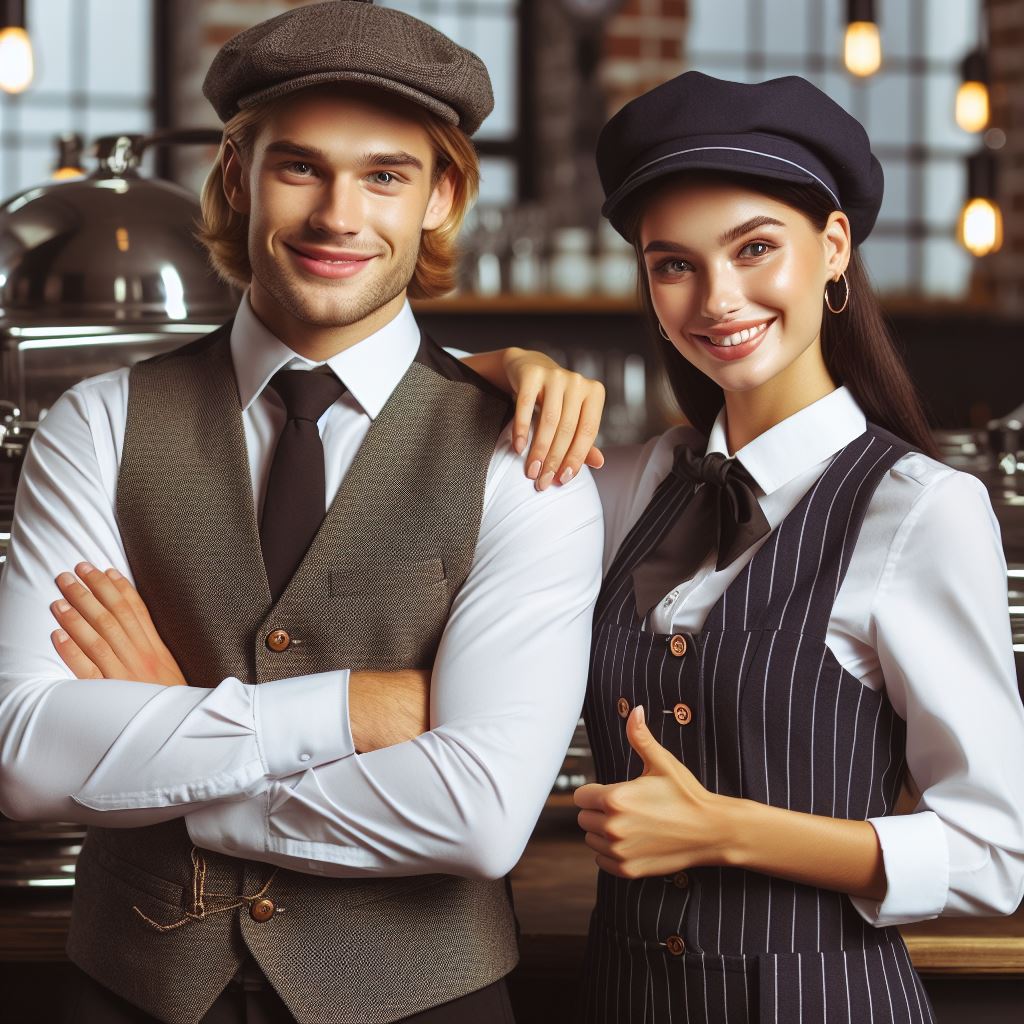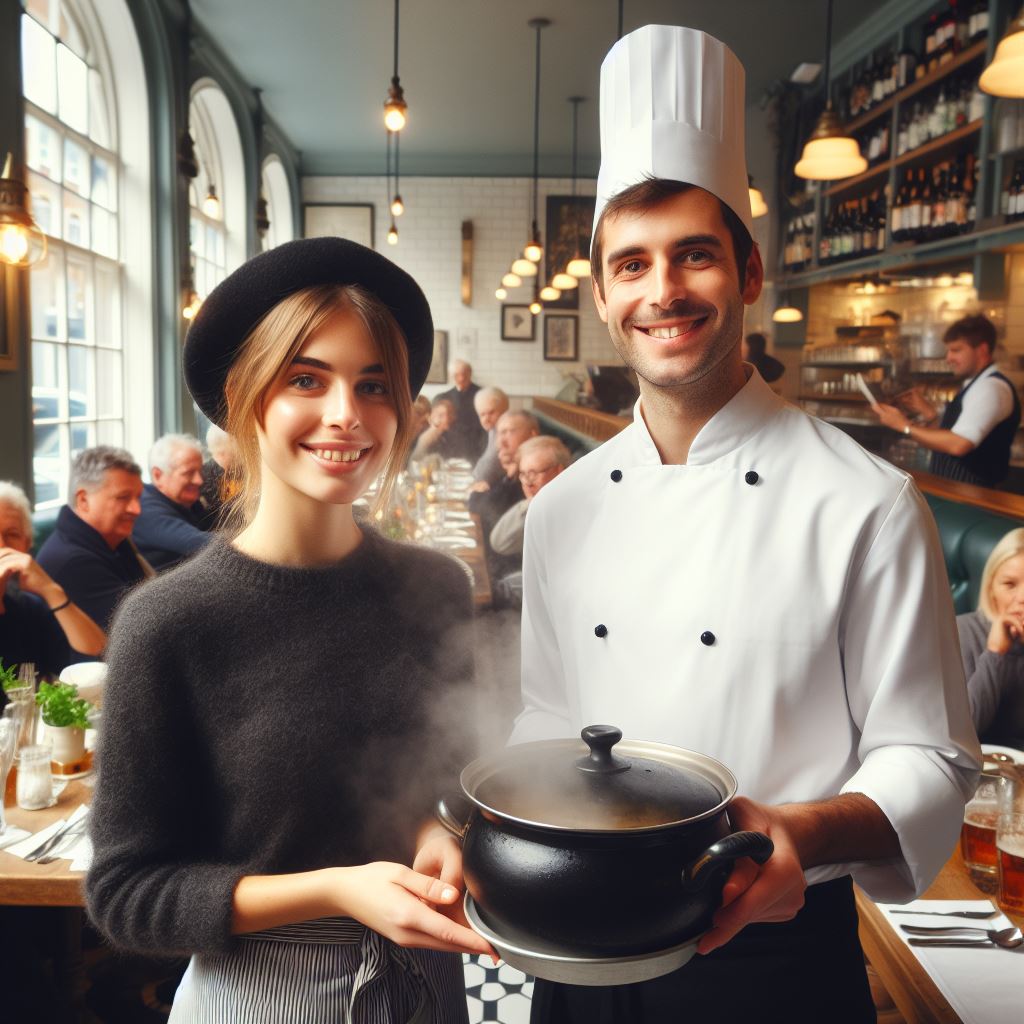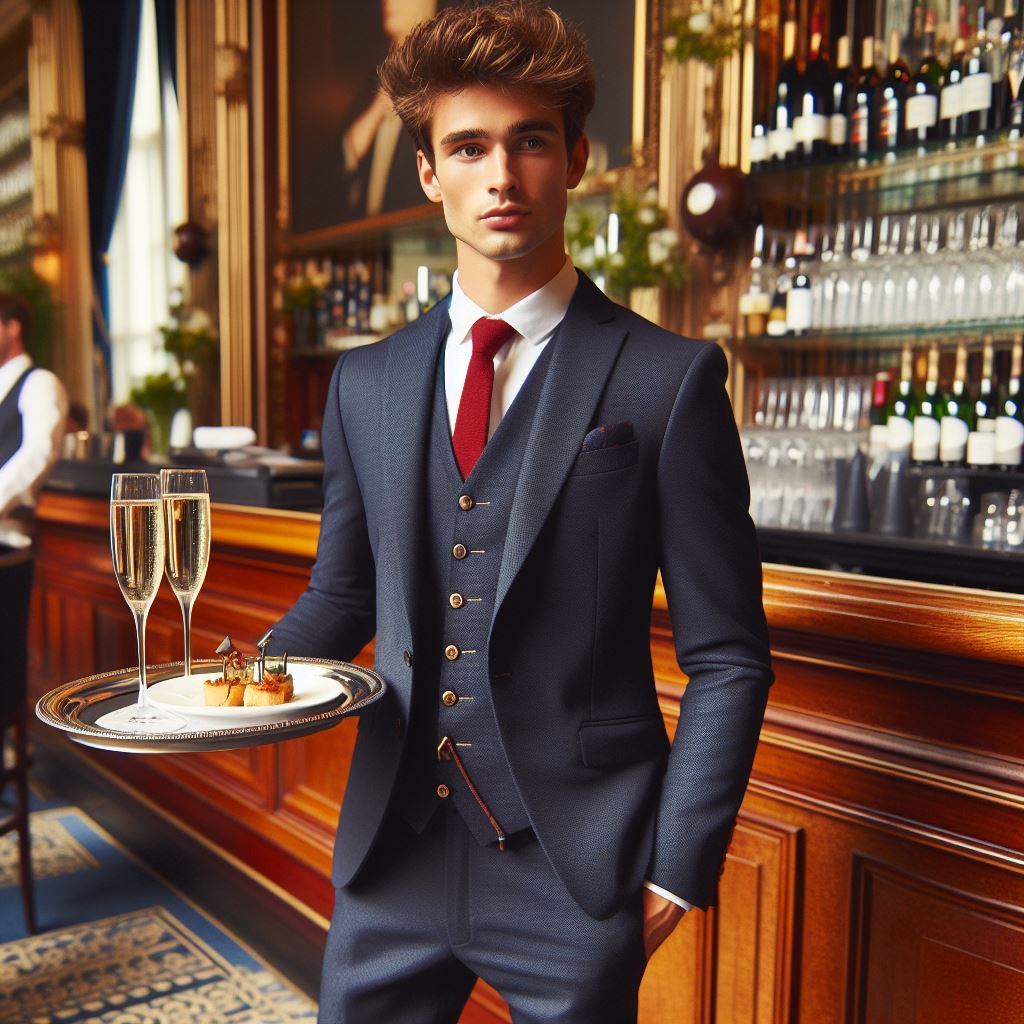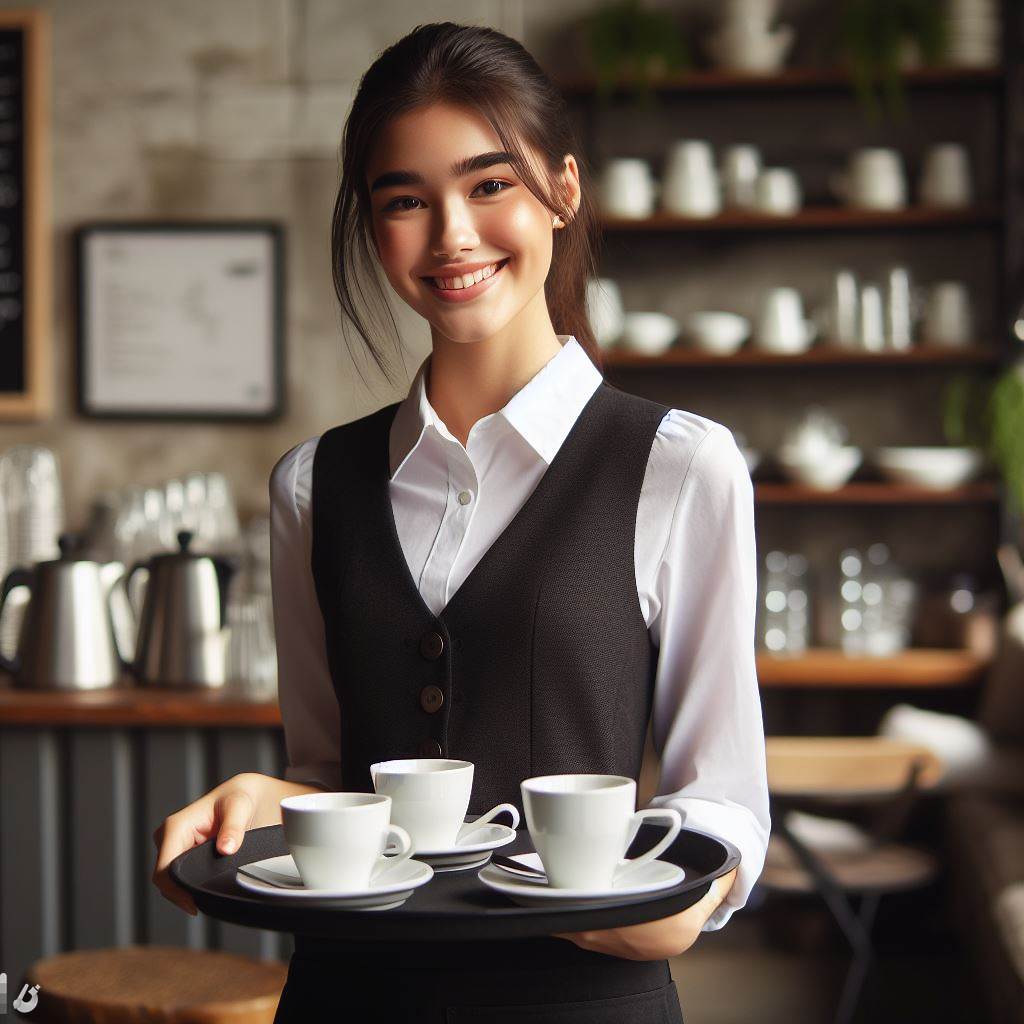Introduction
In the bustling world of UK hospitality, waitstaff uniforms seamlessly blend fashion and function.
These ensembles aren’t merely fabric; they’re a statement, an emblem of professionalism.
As servers navigate crowded dining spaces, their attire becomes a silent communicator, reflecting the establishment’s identity.
The significance lies not only in aesthetic appeal but also in practicality; aprons with clever pockets, sleek designs that enhance mobility.
Functionality is paramount – garments must withstand the demands of a dynamic environment.
In this realm, where service is an art, uniforms embody the harmony between style and utility.
So, whether it’s a quaint tearoom or a trendy bistro, the waitstaff’s attire is a canvas, where fashion meets the demands of the dining experience.
History of Waitstaff Uniforms in the UK
- Waitstaff uniforms have a rich history in the UK, dating back to the 19th century.
- In the past, waitstaff uniforms were simple and practical, designed to reflect professionalism and cleanliness.
- During the Victorian era, waiters wore long tailcoats or frock coats with waistcoats and trousers.
- As the 20th century approached, waitstaff uniforms began to evolve with changing fashion trends.
Evolution of Waitstaff Uniforms from the Past to the Present
- In the 1920s, waitstaff uniforms became more fashionable, reflecting the glamorous Jazz Age.
- Uniforms for male waitstaff included waistcoats, bowties, and crisp white shirts.
- Female waitstaff wore knee-length dresses with aprons, often accessorized with hats and gloves.
- The 1950s introduced a more casual approach with short-sleeved shirts and slacks for male waitstaff.
- Female waitstaff adopted the iconic pinafore dress, which became a staple in many restaurants.
- In recent years, modern waitstaff uniforms emphasize both style and functionality.
- Contemporary uniforms often feature sleek designs, incorporating materials that are easy to clean.
- Male waitstaff may wear slim-fit shirts and tailored trousers for a more sophisticated look.
- Female waitstaff now have options such as tasteful dresses or blouses with skirts and comfortable footwear.
Traditional Elements Incorporated in Modern Uniforms
- The use of aprons remains a traditional element that is still incorporated into modern waitstaff uniforms.
- Aprons not only protect the uniform but also add a touch of nostalgia to the overall look.
- Some establishments still opt for traditional elements like pocket squares for male waitstaff or neckerchiefs for female waitstaff.
- Waitstaff may also wear traditional hats, such as flat caps or Baker boy caps, to enhance their attire.
- Incorporating traditional elements in modern uniforms helps create a sense of authenticity and timeless elegance.
In essence, waitstaff uniforms in the UK have come a long way from their humble beginnings.
From the simplicity of the 19th century to the glamour of the Jazz Age and the casual styles of the mid-20th century, these uniforms have continuously evolved with the changing fashion trends.
Today, modern waitstaff uniforms combine fashion and functionality, providing a sleek and professional appearance.
Despite the evolution, traditional elements, like aprons and hats, are still incorporated to add a touch of nostalgia and maintain a sense of authenticity in the dining experience.
Read: The Impact of Tech on UK Waitstaff Roles
Fashionable Elements in Waitstaff Uniforms
Waitstaff uniforms have evolved to become more stylish and trendy in recent times.
Gone are the days of boring and generic aprons and button-up shirts.
Today, restaurant owners recognize the importance of creating a fashionable and cohesive look for their staff that not only represents their brand but also enhances the dining experience for customers.
One way that waitstaff uniforms have become more fashionable is through the use of colors, patterns, and accessories.
Restaurants now understand that these elements can greatly contribute to the overall ambiance and theme of their establishment.
By carefully selecting colors that align with their brand identity, restaurants can create a visually appealing and memorable dining experience.
Patterns are another way that waitstaff uniforms have become stylish.
From classic pinstripes to bold and modern designs, patterns can add a touch of sophistication and uniqueness to the uniforms.
For example, a high-end fine dining establishment may opt for a subtle and elegant pattern, while a casual cafe may choose a fun and playful pattern to reflect their laid-back atmosphere.
Accessories play a significant role in completing the fashionable look of waitstaff uniforms.
From stylish ties and bow ties to statement jewelry and hats, accessories offer an opportunity for waitstaff to showcase their personality and style.
These accessories not only elevate the uniforms but also help create a more cohesive and polished look for the entire staff.
Now, let’s explore some popular fashion trends in waitstaff uniforms:
- Modern Minimalism: Clean lines, solid colors, and simple yet elegant designs are increasingly popular in waitstaff uniforms.
This trend focuses on creating a sleek and sophisticated look that is both timeless and professional. - Vintage Revival: Nostalgia has made its way into the restaurant industry, and waitstaff uniforms are no exception.
Vintage-inspired uniforms, such as retro aprons, bow ties, and high-waisted pants, give a nod to the past while still being fashion-forward. - Sustainable Fashion: With growing awareness of environmental issues, many restaurants are opting for sustainable fabrics and eco-friendly uniform options.
From organic cotton to recycled materials, these uniforms not only look good but also contribute to a greener future. - Mix and Match: Another popular trend is allowing waitstaff to mix and match different pieces to create their own unique look within certain guidelines.
This approach gives them freedom to express their personal style while still maintaining a cohesive uniform aesthetic.
In short, waitstaff uniforms in the UK have transformed from dull and utilitarian garments into fashionable and trendy ensembles.
The use of colors, patterns, and accessories allows restaurants to reflect their brand or theme, creating a memorable dining experience.
With popular fashion trends like modern minimalism, vintage revival, sustainable fashion, and mix and match, these uniforms not only enhance the visual appeal but also celebrate individuality and style.
Read: UK Etiquette: A Waitstaff’s Perspective
Functional Aspects of Waitstaff Uniforms
The functional aspects of waitstaff uniforms play a crucial role in the success of a restaurant.
- Functionality is important in waitstaff uniforms for practical reasons.
- Comfort is a key consideration in the design of waitstaff uniforms.
- Durability ensures that the uniforms can withstand the demands of the job.
- Easy movement is essential for waitstaff to carry out their tasks efficiently.
- The design of the uniforms must cater to the specific roles within the waitstaff team.
- Waiters and waitresses require uniforms that provide ease of movement and reflect professionalism.
- Bartenders need uniforms that allow them to work efficiently behind the bar.
- Appropriate clothing for different roles within the waitstaff team helps in identifying their functions.
Functionality is a crucial aspect of waitstaff uniforms as they directly impact the efficiency and productivity of the staff.
Comfort is a key consideration, as waitstaff often work long hours on their feet, interacting with customers, and carrying trays of food and drinks.
The design of the uniforms should accommodate the physical demands of the job while ensuring the comfort of the staff.
Durability is another important factor to consider in waitstaff uniforms.
The uniforms need to be able to withstand frequent use, washing, and potential spills or stains.
Durable uniforms not only save costs for the restaurant but also contribute to the professional appearance of the staff.
Easy movement is essential for waitstaff to perform their duties efficiently.
The design of the uniforms should not restrict movements such as bending, lifting, or reaching.
Elastic or stretchable materials can be incorporated into the design to provide flexibility and ease of movement.
Furthermore, it is important for the waitstaff uniforms to be appropriate for the different roles within the team.
Servers, for example, may require long aprons or waistcoats with pockets to carry essentials like notepads and pens.
Bartenders, on the other hand, might need specially designed pockets for bar tools and bottle openers.
Personalized UK Career Consulting
Receive tailored career guidance designed just for you. Get actionable steps and expert support to boost your career in 1-3 days. Take control of your career now.
Get StartedBy ensuring that the waitstaff uniforms are functional, comfortable, durable, and allow for easy movement, restaurants can enhance the overall dining experience for their customers.
Customers are more likely to have a positive perception of a restaurant when the staff appears professional, well-groomed, and appropriately dressed.
Overall, in the fast-paced environment of the hospitality industry, waitstaff uniforms must combine fashion with functionality.
The uniforms should not only reflect the brand and style of the restaurant but also provide practicality and convenience for the staff.
By considering the functional aspects of waitstaff uniforms, restaurants can create a positive and efficient work environment and leave a lasting impression on their customers.
Read: Career Growth for Waitstaff in the UK Hospitality

Delve into the Subject: Understanding UK Travel Trends in 2024
UK Restaurant Industry Standards for Waitstaff Uniforms
In the UK restaurant industry, there are specific standards for waitstaff uniforms that must be followed.
- Regulations and guidelines imposed by the industry are in place to ensure a professional and hygienic appearance.
- Firstly, it is required for waitstaff to wear a clean and well-maintained uniform while on duty.
- The restaurant industry in the UK takes cleanliness and hygiene very seriously.
- Waitstaff must have clean uniforms to avoid any potential contamination of food or drinks.
- Their uniforms should be comfortable, practical, and suitable for the demands of their role.
- The UK restaurant industry emphasizes professionalism and wants waitstaff to represent their establishments well.
- Uniforms play a crucial role in creating a positive and professional impression on customers.
- By adhering to industry standards, restaurants can enhance their overall image and reputation.
- For example, waitstaff are often required to wear black trousers or skirts with a clean white shirt.
- This classic combination presents a clean and polished look, ensuring a professional appearance.
- Restaurants may also require waitstaff to wear a certain type of apron or waistcoat for practical purposes.
- These additions can provide functional benefits such as pockets for carrying order pads or cutlery.
- The uniforms should also have adequate breathability, allowing waitstaff to work comfortably in warm environments.
It is crucial to address the impact of uniforms on hygiene and professionalism within the industry.
- Properly fitted uniforms can contribute to maintaining hygiene standards, as loose-fitting clothing may introduce potential hazards.
- Uniforms that are too tight can also restrict movement and hinder waitstaff’s ability to perform their duties efficiently.
- In terms of professionalism, uniforms establish a sense of cohesion and align the team’s appearance.
- They create a unified image that reflects the values and branding of the restaurant.
- By standardizing the appearance of waitstaff, restaurants can project a more cohesive and professional environment.
- When customers see well-dressed and clean waitstaff, it instills confidence in the establishment’s cleanliness and service quality.
- In contrast, unkempt or unprofessional uniforms may raise doubts about the overall standards of the restaurant.
- Customers are more likely to trust and feel comfortable with waitstaff who are dressed appropriately.
- Thus, by adhering to industry regulations, restaurants can maintain a positive reputation and customer satisfaction.
- In fact, the UK restaurant industry has specific standards for waitstaff uniforms.
- Regulations and guidelines ensure both hygiene and professionalism are maintained.
- The right uniforms contribute to a positive dining experience and enhance the overall image of restaurants.
- By wearing clean, comfortable, and well-fitted uniforms, waitstaff can represent their establishments with pride and professionalism.
- Uniforms play a significant role in the fashion aspect, but more importantly, they meet crucial functional requirements.
- From practicality to cleanliness, waitstaff uniforms are an essential component of the UK restaurant industry.
Read: Waiter’s Guide: Handling Difficult Customers in the UK
Cultural and Regional Influences on Waitstaff Uniforms
When it comes to waitstaff uniforms in the UK, cultural and regional influences play a significant role.
Different cultures and regions within the country have unique uniforms for their waitstaff, often incorporating traditional and cultural elements.
Let’s explore these influences further:
Different Cultures and Regions with Unique Uniforms
- Scotland: Scottish influences can be seen in waitstaff uniforms, with tartan patterns or kilts being incorporated.
- Wales: Welsh cultural elements are often included in uniforms, such as embroidery depicting traditional symbols.
- London: As a diverse and cosmopolitan city, London’s waitstaff uniforms may vary widely, representing the multiculturalism of the city.
- Northern Ireland: Waitstaff uniforms here may showcase traditional Irish designs, such as Celtic knots or shamrocks.
- English Countryside: In rural areas of England, waitstaff uniforms may reflect the traditional English countryside aesthetic, with floral prints or rustic fabrics.
Traditional and Cultural Elements in Uniforms
These unique uniforms often incorporate traditional and cultural elements as part of their design. Some examples include:
- Symbolism: Many waitstaff uniforms feature symbols or motifs that are relevant to the culture or region they represent.
- Colors: Specific colors may be chosen to reflect cultural significance, such as using national flag colors in the uniform design.
- Accessories: Some uniforms include traditional accessories like brooches, sashes, or hats, adding authenticity to the overall look.
- Traditional Fabrics: Certain fabrics with cultural significance, such as Scottish tartan or Irish linen, may be used in the uniforms.
- Embellishments: Embroidery or embellishments inspired by traditional patterns or designs can add a unique touch to waitstaff uniforms.
The incorporation of these traditional and cultural elements not only adds aesthetic appeal but also allows waitstaff to represent their heritage and create an authentic experience for customers.
There is no doubt that cultural and regional influences greatly impact waitstaff uniforms in the UK.
Whether it is the distinct Scottish tartan, the Welsh embroidery, or the English countryside aesthetic, each region and culture brings its own flavor to the uniforms.
These uniforms serve not only as a form of identification but also as a reflection of the diverse and rich cultural heritage within the UK.
Next time you visit a restaurant in the UK, take a moment to appreciate the thought and creativity put into the uniforms of waitstaff.
They are more than just a fashion statement; they are an expression of culture, history, and tradition.
Conclusion
Uniforms of waitstaff in the UK play a crucial role in balancing both fashion and functionality.
These uniforms are designed to not only showcase a restaurant’s brand and image but also provide practical benefits for the staff.
By wearing well-designed uniforms, waitstaff can create a professional and cohesive look that adds to the overall dining experience for customers.
A properly dressed waitstaff can evoke a sense of trust and reliability, making customers feel confident in the establishment.
Your Dream Job Starts with a Perfect CV
Get a tailored CV and cover letter that captures your unique strengths and stands out in your industry. Let us help you make an unforgettable first impression.
Get StartedMoreover, waitstaff uniforms help to distinguish staff members from the customers, allowing for easier identification and ensuring smooth and efficient service.
They also contribute to a hygienic environment, as uniforms can be easily laundered and maintained to meet strict hygiene standards.
These uniforms can enhance the atmosphere and ambiance of a restaurant, contributing to the overall theme and creating a visually appealing experience.
Whether it’s a classic and elegant outfit or a more modern and trendy design, waitstaff uniforms can complement the dining space and provide a cohesive aesthetic.
Waitstaff uniforms in the UK are more than just clothing.
They serve as an essential part of a restaurant’s brand identity while also ensuring functionality and practicality.
These uniforms contribute to the overall dining experience, enhancing customer satisfaction and promoting a professional image for the establishment.
Fashion and function truly meet in the waitstaff uniforms of the UK.
[E-Book for Sale]
500 Cutting-Edge Tech Startup Ideas for 2024 & 2025: Innovate, Create, Dominate
$19.99 • 500 Tech Startup Ideas • 62 pages
You will get inspired with 500 innovative tech startup ideas for 2024 and 2025, complete with concise descriptions to help you kickstart your entrepreneurial journey in AI, Blockchain, IoT, Fintech, and AR/VR.




